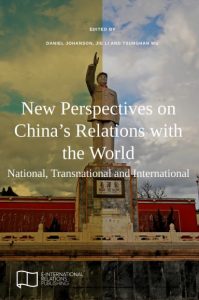
New Perspectives on China’s Relations with the World New Perspectives on China’s Relations with the World Dr Daniel Johanson, Dr Jie Li and Tsunghan Wu Press, 2016, 184 pages The book “New Perspectives on China’s Relations with the World” introduces “China’s Relations with the World: Changing Agenda, New Issues, and Ongoing Debates.” Since the beginning of the 21st century, China has been gaining influence throughout the world. Hence, it is essential to know more about the evolution and progress of Chinese foreign policies. Only then would it be possible to analyse interest and prioritise. The book is an addition to the existing literature on Chinese foreign policies. It gives diverse perspectives on the Chinese interaction with the world. The book has been broadly divided into three parts- National, Transnational and International.
National
There are four chapters in the National section. These chapters deal with issues about the democratic and leadership development in Tibet, Hong Kong and the ethnic minorities of Xinjiang. These chapters discuss the progress made by the Chinses Communist Party (CCP) on security and how they are handling the domestic problems. There has been massive modernisation in recent decades, and China does acknowledge that it is confronting a new set of challenges.
The first chapter is Switching between Accommodation and Suppression: China’s Nation-Building Strategies and United Front Work for Tibetan Leadership. It discusses China’s desire to create a multi-ethnic society while ensuring that Chinese national identity is considered superior to other ethnicities. In this process, he identifies the accommodation and suppression method adopted by the CCP since the 1950s with the latter method since the early 1990s to accommodate Tibet in the Chinses mainland successfully. Tsunghan Wu states that despite this integration, a growing conflicting dynamic need to be looked upon by the CCP.
The second chapter– The Changing Security Dimension of China’s Relations, discusses the China’s relations and the changes in the security dynamics of with Xinjiang. The region is exceptionally strategic for China. It wants to revive the Silk Road Economic Belt under the Belt and Road Initiative. However, despite significant economic reforms brought in the region, there is still resentment against the regime by the Uyghurs. It is primarily due to the suppressive policies adopted by the CCP to deal with ethnic minorities. Thus, Claudia finally concludes how there is a need to review the policies to ensure stability in the region and prevent the separatist ideology.
The third chapter – Mechanisms behind Diffusion of Democracy in the Pearl River Delta Region, discusses that despite PRC’s attempts to weaken the democratic institutions in Hong Kong and Taiwan, these regions still hold the basis to influence democratisation development in the Chinese mainland. In order to have a further understanding of the democratisation process, Gustav uses 18 interviews from 20 respondents from the labour governmental organisation in the Pearl River Delta Region. He further divided their responses into four categories- consulting, financing, provision of free space, and international networks to spread democracy.
From a broader perspective, the study is a first step to have an in-depth understanding of how democracy is instilled at the grassroots level. The discussion also allows us to know the desire of these labour organisations to have a democratic system, that is, though distinct from the systems in Hong Kong and Taiwan, but inspired by them. Last but not least, Sundqvist has possibly laid the foundation for more follow-up studies in this field.
The final and the fourth chapter in this section – “One Country, Two Systems Under Siege: Rival Securitising Attempts in the Democratisation of Hong Kong,” discusses the One Country, Two Systems concept built to avoid clashes between political units. The arguments originate from the pro-self-determination camp and the pro-establishment camp. Li analyses the origin of the arguments put forth by these camps and states that the whole system built as a “political buffer” is now under threat. The pro-self-determination camp demands independence to secure democracy in Hong Kong. On the other hand, the establishment of the treason laws in Hong Kong demands the pro-establishment camp to ensure no uprising against the PRC, considering the recent protests held in the city-state. Nonetheless, Li concludes that these loggerhead issues would only further the security issues and create more instability rather than solve the issue.
Transnational
The Transnational section is further divided into four chapters. Each chapter deals with several unique and distinct aspects of Chinese foreign policy.
The fifth chapter – Public Diplomacy: China’s Newest Charm Offensive, discusses the concept of ‘public diplomacy’ that has replaced the ‘charm offensive’ that described the Chinese foreign policies. The chapter is further divided into three parts. The first part delineates ‘public diplomacy’ and the progress within the country to expand the function of the changes in the policy. The second part is ‘telling a good story of China’ that involves the creation of a certain image of China that showcases its friendliness rather than its aggressiveness. Third part discusses the contribution of the Confucius Institute and China Cultural Centre. For a long time, the institution has been using the tool of ‘public diplomacy’ to promote Chinese culture across the world. Concisely, the chapter provides a short insight into how China’s global image has progressed and the subsequent challenges that still need to be addressed by the country.
The sixth chapter – Can China Link the Belt and Road Initiative by Rail? deals with connecting the Railroad Economic Belt (REB) with the Belt and Road Initiative (OBOR) to deepen the OBOR program in other countries and thus increase the Chinese influence in those regions. The author expounds on how China controls the railway sector and ensures technological and innovation advancement in the industry is exported via the OBOR route. The commercial sectors are also aligned with the state machinery to further the Chinese influence in the region, building institutions that support the Chinese endeavours and counter the West influence. China is already connecting with other countries through the Belt and Road Initiative and exporting its REB via the same route. Thus, Yan concludes that despite progress in attaining its goal, a lot still needs to be done, primarily due to varied political scenarios in other countries.
The seventh chapter – The Transnational in China’s Foreign Policy: The Case of Sino-Japanese Relations, discusses the concept of all steps taken to ensure that the relations between the two countries move positively beyond the Senkaku island dispute and the second Sino-Japanese war. Unlike in other situations where researchers analyse the missteps taken in the regions, Wits has a different approach towards solving a problem. He argues that it is essential to analyse what steps were taken to improve the relations and restructure the current scenario. In this chapter, he discusses that people-to-people diplomacy and the transnational network would be beneficial to solve the current tensions prevailing between the two countries.
In the final and eighth chapter of the section, Soviet Foreign Policy in the Early 1980s: A View from Chinese Sovietology, Jie Li focuses on how the Chinese research experts observed and analysed the Soviet Union foreign policies. It was done so that China could challenge the USSR role in leading the developing countries in the socialist world and parallelly create an altruistic image of China. Through their research work, they tried to authenticate the role of the CCP and the Chinese method of socialism and leadership over the USSR. Not only that but also to convince the world that Chinese leadership was the future that the Chinese anticipated.
International
It is the last section of the book, and it comprises four chapters.
The ninth chapter – Overcoming the Greatest Distance: China in Latin America discusses China’s growing relations and role in the Latin America region. The trend began with President Jiang Zemin’s visit to the region in 2001. It was followed by several visits by numerous Chinese business houses that opened the possibility of Chinese-Latin America relations. The author argues that the Chinese are trying to include several regions under its Belt and Road initiative, with potential for market growth and political and economic development scope. The chapter gives an insight into the foreign policy alignment of China. It extensively analyses how Chinese policies are accommodating according to the required engagement, the development of the Sino-Latin America relations for the past years and the scope for further progress in future.
In the tenth chapter – China’s Multilateral Diplomacy in Africa: Constructing the Security-Development Nexus, Carrozza argues an urgent need to re-examine the current studies on socialisation. It is because these studies tend to lean towards the norms established by the West. As a result, there has been a lack of formal studies on the socialisation dynamics in China. Secondly, the author also discusses the usage of the Forum on China-Africa Cooperation by China. For a long, China has been creating an environment of countering Western hegemony in the African region and posing as a developing country that will assist Africa in its prosperity. In the process, the African leaders have accepted the Chinese narrative. They have made it an irreplaceable ally in the peace and security issues in the region. At the same time, China gets to further its soft diplomacy in the region and further its interests.
The eleventh chapter – Becoming a ‘Responsible Power’? China’s New Role during the JCPOA Negotiations discusses the growing interest of China in Iran. Since the beginning of the 21st century, China was always hesitant to lean towards a particular side on international issues that do not concern it. China only reacted to international issues where it could gain from its involvement. However, there has been a recent change in that policy when China started to take an active role in the Iran sanctions and the nuclear deal.
The chapter discusses how China played a crucial role in the 2010 sanctions on Iran that brought the country back to the negotiation table. Alongside this, China also expressed to the international community to trust Iran on the nuclear deal. However, China did take a crucial step by supporting stricter sanctions on Iran when the UN resolution protocols were not met. Overall, Daniel Johnson highlights the importance of the Chinese role in upholding the JCPOA negotiations in the past and future.
In the last and twelfth chapter of the book- The Evolution of Sino-Japanese Relations: Implications for Northeast Asia and Beyond, Nori Katagiri discusses two factors affecting Sino-Japanese relations. The concept of balance of power and the consequent impact of the external environment factors on the relations are discussed. Katagiri argues that there has been a growing mistrust among the nation’s policymakers and the public alike. There have been improvements in the relations Protests, island disputes, cyber-attacks, and the opinion held by the public of the respective countries makes the situation worse. The only reason why these relations have not hit a new low is due to the socioeconomic cooperation and interdependence between the two countries. However, if these issues are not solved, these bilateral tensions would only add to the existing chaos in the East Asian region.













